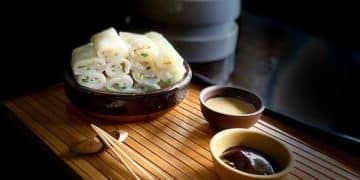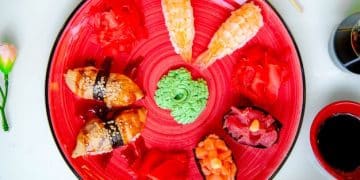Japanese Drama Food Food Culture: Recreating Popular Dishes from Your Favorite Shows
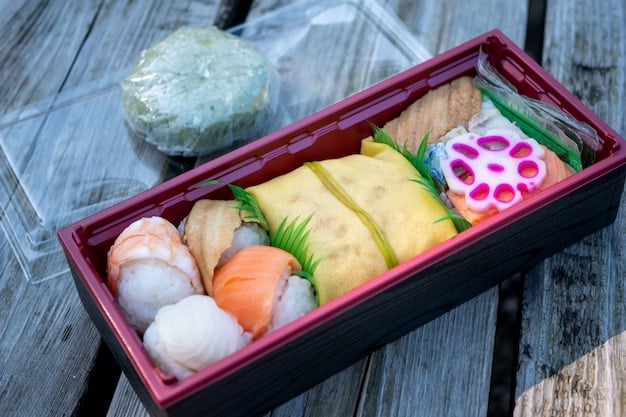
Exploring the rich intersection of Japanese culinary traditions and captivating storytelling, this article delves into Japanese Drama Food Culture: Recreating Popular Dishes from Your Favorite Shows, offering insights and practical guidance for fans to bring their favorite onscreen meals to life in their own kitchens.
Ever found yourself watching a Japanese drama, captivated not just by the plot, but by the delicious-looking food being savored on screen? Japanese Drama Food Culture: Recreating Popular Dishes from Your Favorite Shows offers a unique window into the heart of Japan, showcasing its culinary artistry and deep cultural connection to food. It’s an immersive experience that often leaves viewers craving a taste of what they’ve seen. Join us as we explore this fascinating world and discover how you can recreate these iconic dishes in your own home.
The irresistible allure of food in Japanese dramas
Japanese dramas, often referred to as J-dramas, have a unique way of integrating food into their narratives. It’s not just about sustenance; food often serves as a character in itself, driving plot points, revealing character traits, and evoking strong emotional connections. From the comforting warmth of a simple bowl of ramen to the intricate artistry of a bento box, each dish tells a story, making the audience feel part of the culinary journey.
This careful portrayal of food reflects Japan’s profound reverence for its culinary heritage, where cooking is seen as an art form and eating as a communal experience. The visual presentation, the sounds of preparation, and the reactions of the characters enjoying their meals are all meticulously crafted to entice and engage the viewer, creating a powerful sensory experience that transcends the screen.
More than just sustenance: food as narrative and identity
In many J-dramas, food plays a symbolic role, representing comfort, healing, or tradition. A character might find solace in a childhood dish, or a shared meal could bridge cultural divides. This depth adds layers to the storytelling, making the food not just appealing to the palate, but also to the soul. It reflects how food is interwoven with daily life and personal history in Japan.
- Food as a language of love and care.
- Culinary challenges as character development arcs.
- Traditional dishes preserving cultural heritage.
- Shared meals fostering community and reconciliation.
The attention to detail in food styling and preparation techniques in J-dramas is also remarkable. Viewers are often treated to close-ups of ingredients being sliced, sauces simmering, and dishes being artfully plated. This visual feast elevates the culinary experience, inspiring many to try their hand at replicating these dishes at home.
The cultural impact of these food scenes extends beyond entertainment. They often introduce international audiences to niche Japanese cuisines or cooking methods they might not otherwise encounter. This exposure fosters a deeper appreciation for Japanese culture and encourages culinary exploration, turning viewers into active participants in the food story.
Ultimately, the irresistible allure of food in Japanese dramas lies in its ability to connect with viewers on multiple levels – visually, emotionally, and culturally. It transforms the act of watching into an invitation to discover, taste, and experience the rich tapestry of Japanese food culture.
Decoding popular J-drama dishes: what to look for
To successfully recreate dishes from your favorite J-dramas, it’s essential to first understand what makes them so appealing and how to identify key components. This involves more than just seeing a dish; it requires a keen eye for detail, an understanding of common Japanese ingredients, and an appreciation for presentation.
Many popular J-drama dishes are comfort foods, often prepared at home or in small local eateries. They might seem simple at first glance, but their appeal lies in the delicate balance of flavors, fresh ingredients, and thoughtful preparation. Look for recurring themes like bento boxes, ramen, tonkatsu, omurice, and various types of noodles.
Identifying key ingredients and cooking methods
Pay close attention to how the food is prepared on screen. Are they stir-frying? Deep-frying? Simmering? These methods are crucial clues. Also, try to identify the main ingredients. For instance, if it’s a bowl of ramen, note the type of broth (tonkotsu, shio, shoyu, miso), the toppings (chashu, egg, nori, menma), and the noodle texture. This detailed observation is your first step towards accurate replication.
- Observing specific cutting techniques.
- Recognizing spices or aromatics used.
- Noting the color and consistency of sauces.
- Differentiating between various types of rice or noodles.
Dramas often highlight the fresh, seasonal nature of Japanese cuisine. Ingredients are usually prepared to emphasize their natural flavors rather than overpowering them. This minimalist approach often requires high-quality, fresh produce, meat, or seafood, which contribute significantly to the authentic taste of the dish.
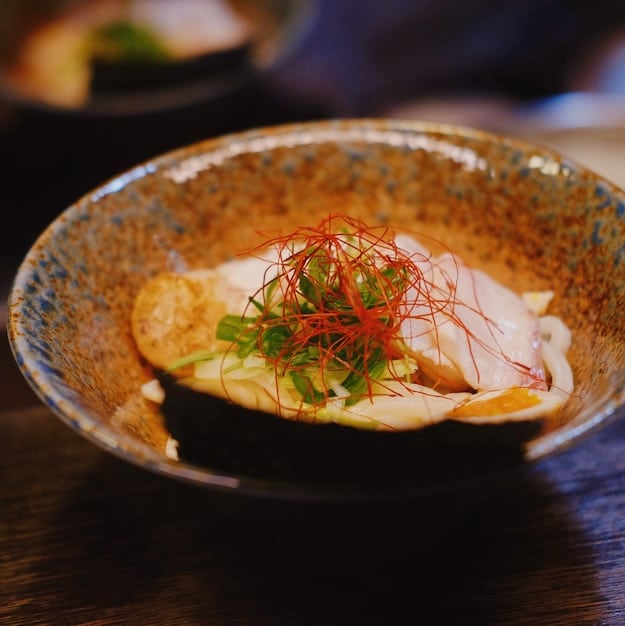
Another aspect to decode is the plating and presentation. Japanese cuisine places a high emphasis on aesthetics. Dishes are often arranged beautifully, with attention to color, texture, and form. Even a simple rice ball might be thoughtfully shaped. Try to replicate this visual appeal when you cook, as it enhances the dining experience.
By carefully observing these elements—ingredients, cooking methods, and presentation—you can start to unravel the secrets behind your favorite J-drama dishes. This methodical approach will not only improve your cooking but also deepen your appreciation for the complexity and artistry of Japanese culinary traditions.
Essential Japanese pantry staples for J-drama cooking
Embarking on a culinary journey into J-drama food culture requires stocking your pantry with a few essential Japanese staples. These ingredients form the backbone of many traditional and modern Japanese dishes, providing the distinct umami flavors and textures that define the cuisine. Having them on hand makes spontaneous cooking much easier.
While some specialized ingredients might require a visit to an Asian grocery store, many foundational items are now widely available in larger supermarkets. Investing in good quality versions of these staples will significantly impact the authenticity and flavor of your recreated dishes, bringing them closer to their onscreen counterparts.
Building your authentic Japanese kitchen
Start with the basics: various types of soy sauce (shoyu), mirin (sweet cooking sake), sake (cooking wine), rice vinegar, and dashi granules or konbu and katsuobushi for making fresh dashi broth. These liquids are fundamental for marinades, dressings, and broths. Additionally, consider miso paste for soups and marinades, and sesame oil for flavoring.
- Soy sauce (shoyu): A fundamental condiment and seasoning.
- Mirin and sake: Crucial for adding sweetness and depth to sauces and marinades.
- Rice vinegar: Essential for sushi rice and adding tang to dishes.
- Dashi: The savory broth base for many Japanese dishes, providing umami.
- Miso paste: Fermented soybean paste, vital for miso soup and dressings.
Beyond liquids, include Japanese short-grain rice, which is sticky and perfect for eating with chopsticks. Nori (dried seaweed) is versatile for rice balls and sushi. Panko breadcrumbs are excellent for achieving a crispy texture in fried foods like tonkatsu. Wasabi and pickled ginger are also key for sushi-related dishes.
For fresh ingredients that you’ll replenish regularly, consider green onions, ginger, and garlic. These aromatics are used in a wide array of Japanese dishes. Fresh tofu, various mushrooms (shiitake, enoki), and daikon radish are also common and add texture and flavor profiles.
Don’t forget specialty noodles! Udon, soba, and ramen noodles each have their unique texture and uses, often starring in their own dedicated J-drama episodes. Keeping a variety of these on hand allows for quick and diverse meal preparations, mirroring the diverse culinary scenes observed in the dramas.
Gradually building your Japanese pantry will allow you to confidently experiment with and recreate a broad spectrum of dishes from your favorite J-dramas. Each staple plays a vital role in achieving that authentic Japanese flavor profile, turning your kitchen into a gateway to the culinary world of Japan.
Recreating iconic J-drama dishes: step-by-step guides
The true joy of engaging with J-drama food culture comes from bringing those captivating dishes to your own table. Recreating iconic meals from your favorite shows is a rewarding experience, allowing you to not just taste, but also embody the spirit of the drama. Here, we offer step-by-step guides to common and beloved dishes.
While authenticity is often the goal, don’t be afraid to adjust recipes to your preferences or available ingredients. The essence of good cooking lies in enjoyment and experimentation. Moreover, many Japanese home cooks adapt recipes to suit their family’s tastes, a practice you can adopt too.
Omurice: a comforting classic
Omurice, a fluffy omelet served over ketchup-flavored rice, is a staple comfort food often seen in J-dramas. Its visual appeal and satisfying taste make it a perfect dish to start with. The key is in the omelet’s texture—soft and slightly runny on the inside.
- Prepare the Ketchup Rice (Chikin Rice): Sauté diced chicken and onions until tender. Add a generous amount of cooked Japanese short-grain rice and mix well. Stir in ketchup, a touch of soy sauce, and a pinch of sugar. Cook until the rice is heated through and flavors are combined.
- Make the Omelet: Whisk 2-3 eggs lightly with a splash of milk or cream. Heat a non-stick pan with a little oil over medium-high heat. Pour in the egg mixture, swirling to coat the bottom. As the edges set, gently push the cooked egg towards the center, tilting the pan to allow uncooked egg to flow underneath.
- Assemble: Once the omelet is mostly set but still slightly creamy on top, slide it over the mound of ketchup rice. Some prefer to fold the omelet around the rice, while others simply drape it over. Drizzle with extra ketchup or demi-glace sauce for finishing.
This dish is incredibly versatile; you can add other ingredients to the chikin rice like mushrooms or peas. The delicate balance between the savory rice and the rich egg is what makes omurice so beloved.
Tonkatsu: crispy, savory delight
Tonkatsu, a breaded and deep-fried pork cutlet, is another J-drama favorite, often depicted as a hearty, satisfying meal. The secret to perfect tonkatsu lies in the crispiness of the panko breading and the tenderness of the pork.
- Prepare Pork: Use a boneless pork loin or tenderloin cut about 1/2 inch thick. Pound it lightly to an even thickness. Season with salt and pepper.
- Breading: Set up a breading station with three bowls: one for flour, one for beaten egg, and one for panko breadcrumbs. Dredge the pork cutlet first in flour, shaking off excess, then dip in egg, and finally coat thoroughly in panko, pressing gently to adhere.
- Frying: Heat vegetable oil in a deep pot to 340-350°F (170-175°C). Carefully lower the breaded cutlet into the hot oil. Fry for 4-5 minutes per side, or until golden brown and cooked through. Drain on a wire rack.
- Serve: Slice the tonkatsu into strips and serve with shredded cabbage and tonkatsu sauce.
Served with a side of rice and miso soup, tonkatsu makes a complete and satisfying meal that transports you straight into a bustling Japanese diner scene. The contrast of the crispy exterior and juicy interior is truly delightful.
These two dishes represent just a fraction of the culinary delights showcased in J-dramas. Each offers a unique opportunity to immerse yourself further into the culture and enjoy the process of bringing fictional food to delicious reality in your own home.
Where to find authentic Japanese ingredients and tools
Sourcing authentic Japanese ingredients and specialized tools is key to recreating dishes from your favorite J-dramas with accuracy. While some items are now readily available, others might require a bit more effort. Knowing where to look will significantly enhance your culinary endeavors, ensuring your dishes taste as authentic as they appear on screen.
The availability of Japanese ingredients has increased dramatically over the years, making it easier for enthusiasts to explore this rich cuisine. From local markets to online retailers, various options cater to different levels of accessibility and product range. Always prioritize quality, especially for foundational ingredients like soy sauce or miso.
Local Asian markets and international grocery stores
Your first stop should be local Asian markets, especially those specializing in Japanese, Korean, or Chinese goods. These stores typically carry a wide array of authentic ingredients, from different types of rice and noodles to specialized sauces, seasonings, and fresh produce common in Japanese cooking. You’ll also find unique snacks and kitchenware.
- Wide selection of fresh and packaged Japanese goods.
- Knowledgeable staff who can offer recommendations.
- Opportunities to discover new ingredients.
- Competitive pricing for bulk purchases.
Larger international grocery stores or organic food markets sometimes have dedicated international food aisles with a good selection of Japanese staples. While the range might be smaller than a specialized Asian market, you can often find basic necessities like soy sauce, mirin, rice vinegar, and even some types of miso and noodles.
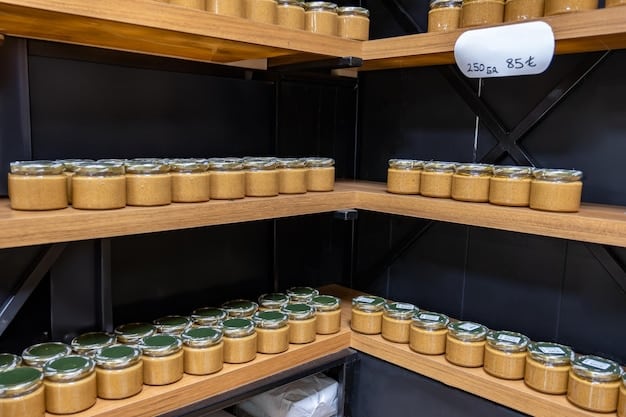
Online retailers and specialty shops
For those without access to well-stocked local markets, online retailers are an invaluable resource. Websites specializing in Japanese or Asian groceries can ship a vast range of products directly to your door, including perishable items with proper packaging. This is particularly useful for hard-to-find ingredients or specific brands.
Beyond ingredients, consider investing in a few essential Japanese cooking tools. A good quality Japanese chef’s knife (gyuto), a tamagoyaki pan for perfect rolled omelets, and a donabe (clay pot) for hot pot dishes are examples. While not strictly necessary for beginner recipes, these tools can elevate your cooking experience and results, mirroring the precision often seen in J-dramas.
Exploring these avenues for sourcing ingredients and tools will not only equip your kitchen but also deepen your understanding and appreciation for Japanese culinary practices. With the right resources, recreating the magic of J-drama food culture becomes an achievable, delicious reality.
Beyond the plate: cultural nuances of food in Japan
Understanding Japanese food culture goes far beyond just recipes and ingredients; it delves into deep-seated traditions, etiquette, and philosophy. In J-dramas, food scenes often subtly highlight these cultural nuances, offering viewers a glimpse into the unspoken rules and values associated with dining in Japan. Appreciating these elements enriches your experience.
For instance, the emphasis on seasonal ingredients (shun) is a cornerstone of Japanese cuisine, reflecting a respect for nature’s bounty and the transient beauty of each season. This sensitivity to seasonality often dictates the menu in both homes and restaurants, a detail often subtly portrayed through the dishes served in various drama episodes.
Etiquette and presentation: the art of dining
Japanese dining etiquette is elaborate and thoughtful. This includes everything from how chopsticks are used (never sticking them upright in rice) to the proper way to hold bowls. While not explicitly taught in J-dramas, observation can reveal these practices. Also, the meticulous presentation of food (moritsuke) is crucial, elevating a meal to an art form.
- Always say “itadakimasu” before eating and “gochisousama deshita” after.
- Don’t pass food from chopstick to chopstick.
- Slurping noodles is considered polite and desirable, indicating enjoyment.
- Never eat directly from communal dishes; use serving utensils.
The concept of mottainai, which expresses regret over waste, is also deeply embedded in Japanese food culture. This philosophy encourages nose-to-tail eating, utilizing every part of an ingredient, and reducing food waste. Many dishes in J-dramas might feature humble ingredients transformed into delicious meals, reflecting this value.
Furthermore, food in Japan is often linked to social bonds and family connection. Sharing a meal is a significant act of hospitality and strengthens relationships. Many J-dramas feature characters bonding over home-cooked meals or sharing stories at local eateries, underscoring the communal and emotional aspect of food.
By exploring these cultural dimensions alongside your culinary experiments, you gain a more holistic understanding of Japanese food. It transforms eating into an experience that connects you not just to the flavors, but also to the traditions, values, and heartwarming narratives that make J-drama food culture so captivating and profound.
Bringing it to your table: tips for success and sharing your J-drama culinary journey
Recreating J-drama dishes is more than just cooking; it’s an immersive experience that allows you to connect with the shows on a deeper level. To ensure success and make the most of your culinary adventures, a few practical tips can make all the difference, transforming your kitchen into a stage for your own edible dramas.
Remember that practice makes perfect. Don’t be discouraged if your first attempt isn’t exactly like what you saw on screen. Embrace the learning process, experiment, and most importantly, have fun with it. Cooking should be an enjoyable journey of discovery.
Tips for successful J-drama food recreation
Start simple: Begin with less complex dishes like tamagoyaki (rolled omelet) or a basic miso soup before tackling elaborate ramens or multi-component bento boxes. Mastering foundational techniques will build your confidence and skills for more intricate recipes.
Invest in quality ingredients: While not always necessary to break the bank, using good quality rice, fresh produce, and authentic sauces will significantly enhance the flavor and authenticity of your dishes. The difference is often noticeable.
Pay attention to presentation: Japanese cuisine emphasizes visual appeal. Even if your cooking implements are basic, take the time to arrange your food neatly. Simple garnishes like chopped green onions or a sprinkle of sesame seeds can elevate a dish significantly.
Taste as you go: Adjust seasonings like soy sauce or mirin to suit your personal preference. Recipes are guides, not rigid rules. Your palate is your best judge of what tastes good.
Don’t be afraid to experiment: Once you’ve mastered a basic recipe, try adding your own twists or incorporating ingredients you enjoy. This personalizes the dish and makes it truly yours, much like how home cooks in Japan adapt recipes over generations.
Sharing your culinary journey
Documenting your cooking adventures can be a fun way to track your progress and share your passion. Take photos of your finished dishes, write down your experiences, and note any modifications you made. This creates a personal culinary journal that you can look back on.
Join online communities or social media groups dedicated to Japanese food or J-dramas. Share your successes and challenges, ask for tips, and connect with fellow enthusiasts. This sense of community adds another layer of enjoyment to your culinary journey, fostering connections with like-minded individuals worldwide.
Ultimately, bringing J-drama food to your table is about more than just satisfying a craving. It’s about cultural exploration, culinary skill development, and creating memorable experiences. So, gather your ingredients, turn on your favorite J-drama, and let the flavors transport you straight to the heart of Japan.
| Key Point | Brief Description |
|---|---|
| 🎬 Food & Narrative | Food in J-dramas drives plots, reveals characters, and evokes strong emotions, reflecting Japan’s deep culinary reverence. |
| 🍜 Decoding Dishes | Observe ingredients, cooking methods, and presentation to recreate iconic dishes like omurice and tonkatsu. |
| 🛒 Pantry Essentials | Stock up on soy sauce, mirin, sake, rice vinegar, dashi, and miso for authentic Japanese flavors. |
| ✨ Cultural Nuances | Understand Japanese dining etiquette, seasonality (shun), and the concept of mottainai for a richer appreciation. |
Frequently asked questions about Japanese drama food culture
Food’s prominence in Japanese dramas reflects its integral role in Japanese culture, symbolizing comfort, connection, and tradition. It often serves as a storytelling device, revealing character emotions, driving plot points, and showcasing Japan’s deep appreciation for culinary artistry and precise preparation techniques. This makes food an essential, almost character-like, element in many narratives, drawing viewers deeper into the world of the shows.
Many beloved J-drama dishes are accessible for home cooks. Popular examples include omurice (omelet over ketchup rice), tonkatsu (deep-fried pork cutlet), various types of ramen, donburi (rice bowls with toppings), and simple bento box components. These dishes often showcase comforting flavors and achievable cooking techniques, allowing fans to bring a piece of their favorite drama home with relatively little difficulty or specialized equipment.
Authentic Japanese ingredients can be found in several places. Your best bet is typically a local Asian grocery store, which offers a wide selection of specialized Japanese products. Larger international supermarkets may also carry some essential items. Additionally, numerous online retailers specialize in Japanese food products, delivering them directly to your door, making it convenient for those without local access.
While not strictly necessary for every recipe, certain tools can significantly enhance your Japanese cooking experience. A good quality Japanese chef’s knife (gyuto), a tamagoyaki pan for rolled omelets, and a suribachi (Japanese mortar and pestle) are helpful. For deep-frying, a deep pot with a thermometer is useful. For beginners, however, standard kitchen equipment will suffice for most J-drama inspired dishes.
Beyond sustenance, food in Japan embodies cultural values such as seasonality (shun), minimizing waste (mottainai), and meticulous presentation (moritsuke). Dining etiquette, like saying “itadakimasu” before meals, is deeply ingrained. Food also plays a crucial role in social bonding, hospitality, and preserving traditions, acting as a medium for connecting people and expressing care, themes often central to J-drama narratives.
Conclusion
The culinary landscape of Japanese dramas offers more than just visual appeal; it’s a gateway to understanding a rich and fascinating culture. From the comforting warmth of a humble bowl of ramen to the intricate artistry of a bento box, food in J-dramas is a powerful narrative tool that evokes emotion, builds character, and showcases Japan’s profound connection to its culinary heritage. By delving into Japanese Drama Food Culture: Recreating Popular Dishes from Your Favorite Shows, viewers transform from passive observers to active participants in this delicious world. Equipping your pantry with essential ingredients, honing your cooking techniques, and embracing the cultural nuances behind each dish allows for an engaging and truly satisfying journey. So, next time you’re enjoying a J-drama, let the food scenes inspire you to bring a piece of that magic into your own kitchen, creating not just a meal, but an experience that embodies the spirit of Japan.
